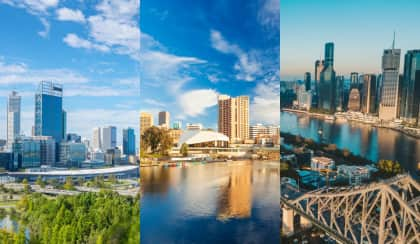Home values record September surge
Australian property prices have recovered the entirety of last season’s downswing losses, new data revealed.

PropTrack’s Home Price Index for September found Australian property prices returned to their peak during the first month of spring, with the value declines recorded throughout the 2022 market downswing all but eradicated from the market. Outside of Darwin, every capital city recorded house price gains in September, ranging from 0.71 per cent in Perth to Melbourne’s 0.25 per cent rise.
Such price gains come against a backdrop of increased buyer activity, with spring selling season kicking off with soaring auction market momentum. Eleanor Creagh, senior economist at PropTrack, said: “Home price growth has been driven by record levels of net overseas migration, tight rental markets and a housing shortage.”
According to the research firm, Brisbane, Adelaide and Perth’s respective markets have hit their peak having reported 5.82 per cent, 8.31 per cent and 9.24 per cent annual growth, respectively.
Ms Creagh noted buyer choice remains limited in this trio of markets’ “heightening competition and seeing prices hit fresh peaks”.
Similarly, CoreLogic’s September Home Value Index (HVI) found national house prices increase 0.8 per cent as the nation continued progressing through an eight-month long housing upswing. Combined with August’s 0.7 per cent HVI lift, the quarterly pace of growth is currently 2.2 per cent, down on the 3 per cent rise reported in the June quarter, with CoreLogic attributing the slowdown to increasing advertised stock levels removing some heat from the market.
Over the September quarter, Perth, Adelaide and Brisbane reported the highest house price increases, while Hobart sat at the opposite end of the spectrum after values declined 0.2 per cent in the Tasmanian capital over the three-month period.
CoreLogic’s research director Tim Lawless said the home values in the trio of capital city markets have benefitted from a subdued listing environment.
“The three capitals recording the highest capital gain each have advertised supply levels that are around 40 per cent below their previous five-year average,” he explained, noting Hobart’s supply levels have been above-average since June last year, highlighting the impact of listings on prices.
Should this growth momentum maintain in the coming months, Mr Lawless expects CoreLogic’s HVI to hit a new nominal high come the end of next month.
“We have already seen dwelling values reach new record highs in Perth and Adelaide [while] Brisbane looks set to reach a new record high in October,” he said. For the pair of Australia’s colder markets, Hobart and Canberra, there is still some time to go before staging a recovery, with Mr Lawless explaining the cities require a 12.4 per cent and 7 per cent value increase respectively before this point is reached.
After leading the market recovery earlier this year, CoreLogic found momentum in the nation’s upper quartile properties eased in the three months to September, reporting 2.3 per cent growth during the period, as opposed to 3.2 per cent growth in the lower quartile.
While Mr Lawless stated lower value capitals, such as Perth and Adelaide, recording a faster rate of growth has inspired this trend, he noted even the lower quartile in these cities is outperforming.
In Sydney and Melbourne, two of Australia’s most expensive markets with median prices of approximately $1.1 million and $776,000 respectively, the middle sector of the market is beginning to experience high growth, with Mr Lawless predicting we are possibly “starting to see renewed affordability challenges deflecting more demand towards the middle of the market where barriers to entry are lower”.
On the regional front, the research firm found every “rest of state” region reporting weaker growth conditions relative to their metropolitan counterparts in September, with regional Australia showing a 1.1 per cent value increase over the September quarter, as opposed to the 2.5 per cent growth seen in the nation’s capital cities during that period.
“Softer housing conditions across regional Australia looks to be more demand-driven, with the estimated number of home sales 6.5 per cent lower than a year ago and 9.2 per cent lower relative to the previous five-year average,” Mr Lawless explained.
“In contrast, the estimated volume of home sales across the combined capital cities was 1.9 per cent higher than a year ago, and 6.3 per cent above the five-year average,” he added.
Moving forward, and with interest rates likely at their peak and population growth ticking along nicely, Ms Creagh believes these factors, paired with a lull in new home builds, should see prices rise.
“As we head further into spring, more markets are likely to reclaim 2022’s fast falls to set new peaks,” she concluded.
